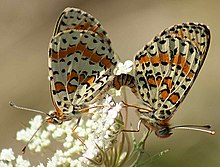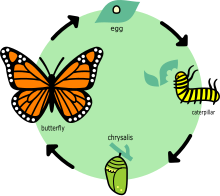Life cycle
 |
| Mating pair of spotted fritillaries on greater pignut |
Butterflies in their adult stage can live from a week to nearly a year depending on the species. Many species have long larval life stages while others can remain dormant in their pupal or egg stages and thereby survive winters.[33] The Melissa Arctic (Oeneis melissa) overwinters twice as a caterpillar.[34] Butterflies may have one or more broods per year. The number of generations per year varies from temperate to tropical regions with tropical regions showing a trend towards multivoltinism.[35]
Courtship is often aerial and often involves pheromones. Butterflies then land on the ground or on a perch to mate.[17] Copulation takes place tail-to-tail and may last from minutes to hours. Simple photoreceptor cells located at the genitals are important for this and other adult behaviours.[36] The male passes a spermatophore to the female; to reduce sperm competition, he may cover her with his scent, or in some species such as the Apollos (Parnassius) plugs her genital opening to prevent her from mating again.[37]
The vast majority of butterflies have a four-stage life cycle; egg, larva (caterpillar), pupa (chrysalis) and imago (adult). In the genera Colias, Erebia, Euchloe, and Parnassius, a small number of species are known that reproduce semi-parthenogenetically; when the female dies, a partially developed larva emerges from her abdomen.[38]
 |
| Life cycle of the monarch butterfly |
Comments
Post a Comment